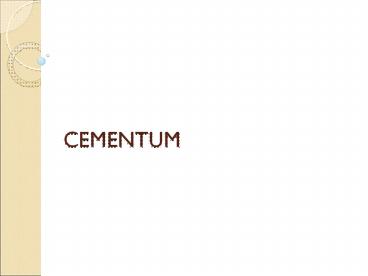CEMENTUM - PowerPoint PPT Presentation
1 / 32
Title:
CEMENTUM
Description:
CEMENTUM * INTRODUCTION Is mineralized dental tissue covering the anatomic roots of human teeth. Begins at cervical portion of the tooth at the cementoenamel junction ... – PowerPoint PPT presentation
Number of Views:658
Avg rating:3.0/5.0
Title: CEMENTUM
1
CEMENTUM
2
INTRODUCTION
- Is mineralized dental tissue covering the
anatomic roots of human teeth. - Begins at cervical portion of the tooth at the
cementoenamel junction continues to the apex. - Furnishes a medium for the attachment of collagen
fibers that bind the tooth to surrounding
structures. - Makes functional adaptation of the teeth
possible. - Unlike bone, human cementum is avascular.
3
(No Transcript)
4
THICK CEMENTUM ON ROOT APICES IN AN ELDERLY PERSON
5
PHYSICAL CHARACTERSTICS
- Hardness is less than that of dentin.
- Light yellow in color.
- Can be distinguished from enamel by its lack of
luster its darker hue. - Semi-permeable to a variety of materials.
6
CHEMICAL COMPOSITION
- Contains 45 to 50 inorganic substances 50 to
55 organic material water. - Cementum has the highest fluoride content of all
the mineralized tissues. - Organic portion consists primarily of type I
collagen protein polysaccharides
(proteoglycans).
7
Cellular components of cementum
8
CEMENTOBLASTS
- Soon after Hertwigs sheath breaks up,
undifferentiated mesenchymal cells from adjacent
connective tissue differentiate into
cementoblasts. - Synthesize collagen protein polysaccharides
which make up the organic matrix of cementum. - Have numerous mitochondria, a well-formed golgi
apparatus, large amounts of granular
endoplasmic reticulum.
9
(No Transcript)
10
(No Transcript)
11
ULTRASTRUCTURE OF CEMENTOCYTE NEAR CEMENTUM
SURFACE.
12
ULTRASTRUCTURE OF CEMENTOCYTES DEEP IN CEMENTUM
13
CEMENTOID TISSUE
- The uncalcified matrix is called cementoid.
- Mineralization of cementoid is a highly ordered
event not the random precipitation of ions into
an organic matrix. - Fibers are embedded in the cementum serve to
attach the tooth to surrounding bone. Their
embedded portions are known as Sharpeys fibers.
14
(No Transcript)
15
Schroeders classification
- Acellular afibrillar cementum
- - Contains neither cells nor extrinsic or
intrinsic collagen fibers, except for mineralized
ground substance. Coronal cementum.(1-15um) - Acellular extrinsic fiber cementum
- - Composed almost entirely of densely packed
bundles of Sharpeys fibers. Cervical third of
roots. (30-230um) - Cellular mixed stratified cementum
- - Composed of extrinsic intrinsic fibers may
contain cells. Co-product of cementoblasts
fibroblasts. Apical third of roots, apices
furcation areas. (100-1000um)
16
- Cellular intrinsic fiber cementum
- Contains cells but no extrinsic collagen fibers.
Formed by cementoblasts. It fills resorption
lacunae. - Intermediate cementum
- - Poorly defined zone near the cementodentinal
junction. Contains cellular remnants of Hertwigs
sheath embedded in calcified ground substance.
17
- Cementum can be differentiated into acellular
cellular cementum. - Acellular cementum does not have spiderlike
cementocytes incorporated into it. - Acellular cementum is found at the coronal half
whereas the cellular cementum is found at the
apical half. - Cementum is thinnest at the cementoenamel
junction thickest toward the apex. - Cementocytes are either degenerating or are
marginally active cells.
18
Acellular cementum
19
CELLULAR CEMENTUM
20
INCREMENTAL LINES
- Are highly mineralized areas with less collagen
and more ground substance than other portions of
the cementum. - The thickness of cementum does not enhance
functional efficiency by increasing the strength
of attachment of the individual fibers.
21
(No Transcript)
22
CEMENTODENTINAL JUNCTION
- Smooth in permanent teeth.
- Scalloped in deciduous teeth.
- Dentin is separated from cementum by a zone known
as the intermediate cementum layer. - This layer is predominantly seen in apical
two-thirds of roots of molars premolars.
23
(No Transcript)
24
CEMENTOENAMEL JUNCTION
- In 60 of the teeth, cementum overlaps the
cervical end of enamel for a short distance. - In 30 of all teeth, cementum meets the cervical
end of enamel in a relatively sharp line. - In 10 of the teeth, enamel cementum do not
meet.
25
RELATION OF CEMENTUM TO ENAMEL AT THE
CEMENTOENAMEL JUNCTION
26
CLINICAL CONSIDERATIONS
- Cementum is more resistant to resorption than is
bone, it is for this reason that orthodontic
tooth movement is made possible. - It is because bone is richly vascularized,
whereas cementum is avascular. - Cementum resorption can occur after trauma or
excessive occlusal forces.
27
- In most cases of repair, there is a tendency to
re-establish the former outline of the root
surface by cementum. This is called anatomic
repair. - However, if only a thin layer of cementum is
deposited on the surface of a deep resorption,
the root outline is not reconstructed, a bay
like recess remains. - In such areas the periodontal space is restored
to its normal width by formation of a bony
projection, so that a proper functional
relationship will result. the outline of the
alveolar bone in these cases follows that of the
root surface. This is called functional repair.
28
HYPERCEMENTOSIS
- Is an abnormal thickening of cementum.
- May be diffuse or circumscribed.
- May affect all teeth of the dentition, be
confined to a single tooth, or even affect only
parts of one tooth. - If the overgrowth improves the functional
qualities of the cementum, it is termed cementum
hypertrophy. - If the overgrowth occurs in non-functional teeth
or if it is not correlated with increased
function, its termed hyperplasia.
29
- Extensive hyperplasia of cementum is occasionally
associated with chronic periapical inflammation. - Hyperplasia of cementum in non-functioning teeth
is characterized by a reduction in the number of
Sharpeys fibers embedded in the root. - Spur or prong like extension of cementum is found
in teeth that are exposed to great stress. - Knob like projections are designated as
excementoses.
30
(No Transcript)
31
ATTACHED CEMENTICLES ON SURFACE OF CEMENTUM
32
THANK YOU






























